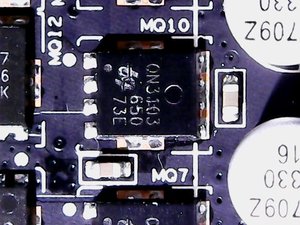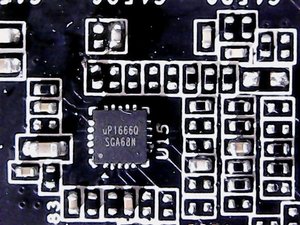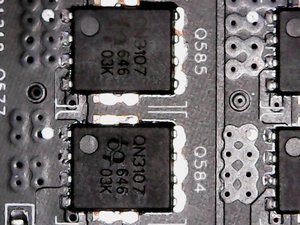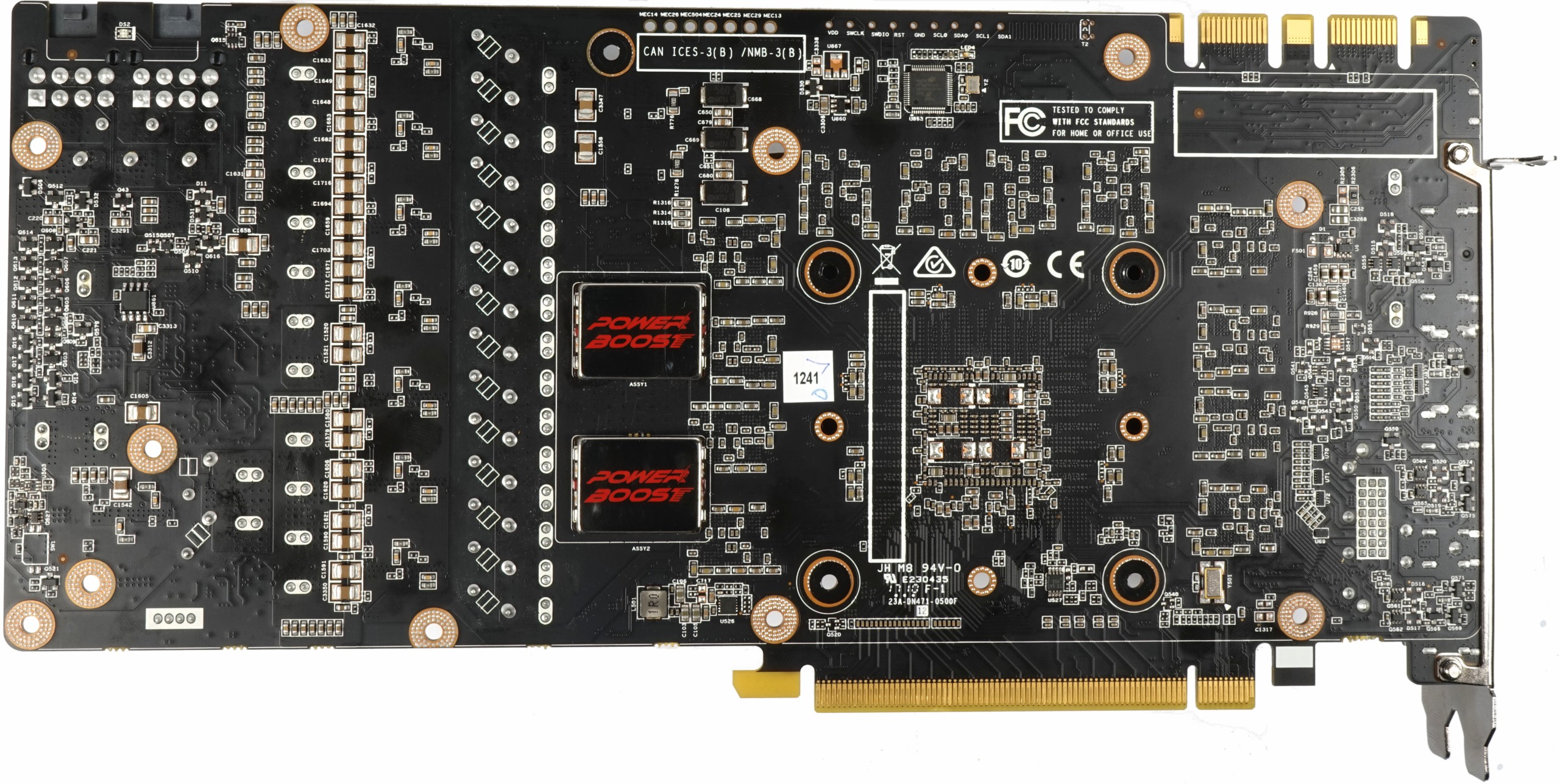Zotac GeForce GTX 1080 Ti AMP Extreme Review
Why you can trust Tom's Hardware
Board & Cooling
A look at the board reveals enough chokes to suggest a 16-phase power supply for the GPU. That's not the whole story, though. In reality, there are eight, and phase doubling allows these to operate as 16 distinct control circuits. Such a dense implementation complicates layout, making it impossible to put all of the related components next to each other. Fourteen of the circuits for seven phases are arranged from top to bottom. The eighth phase, however, is on the board's bottom-right. This isn't particularly great for uniform cooling.
The GPU's eight phases naturally need the right buck controller, and Zotac taps uPI Semiconductor's uP9511 for this role. The uP9111 uses a special uP1961 dual-channel MOSFET driver with phase extension, which then controls two power phases. So, there are 16 phases. But eight are interleaved and current-balanced.


Each power phase employs one UBIQ QN3103 on the high side and two QN3107 MOSFETs on the low side.


The encapsulated ferrite core chokes are familiar. Although they're vertically stacked inside, they cannot solve the problem of insufficient space on Zotac's PCB.
Under their aluminum covers, Zotac's Power Boost components are guaranteed to be nothing more than a circuit board with polymer capacitors designed to smooth out spikes in the supply voltage. However, since stringent requirements are already in place for DC/DC regulation and output-side voltage quality, this is probably just Zotac's answer to the Ultra Durable/Military Class marketing used by its competition.


Another component that stands out is the 32-bit ARM Cortex-M0+ processor made by Holtek, which Zotac uses to control the RGB lighting effects.
A total of 11 Micron MT58K256M321JA-110 GDDR5X ICs are organized around the GP102 processor. They're rated for 11 Gb/s, which helps compensate for the missing 32-bit memory controller compared to Titan X. We asked Micron to speculate why Nvidia didn't use the 12 Gb/s MT58K256M321JA-120 modules advertised in its datasheet, and the company mentioned they aren't widely available yet, despite appearing in its catalog. Because Nvidia sells its GPU and the memory in a bundle, Zotac only has a little room to innovate in this regard.
Get Tom's Hardware's best news and in-depth reviews, straight to your inbox.


Similar to Nvidia's approach with its Titan Xp, Zotac overclocks these memory modules (albeit to 1400 MHz). The jump isn't huge, but it's enough to reach a theoretical bandwidth of 492.8 GB/s, covered under the company's three-year warranty.
A uP1666 two-phase buck controller is responsible for supplying the memory's voltage.


For each of the two power phases, Zotac again relies on one QN3103 on the high side and two QN3107s on the low side. Somewhat simpler SMD chokes are used this time; they're almost identical in design to Foxonn's Magic coils.


Current monitoring is handled by a triple-channel Texas Instruments INA3221.


With three chokes behind the eight-pin connectors, Zotac even adds some kind of filtering. Surely this will be appreciated by more mainstream power supplies tasked with supporting the GeForce GTX 1080 Ti AMP Extreme.
Around back, we see components lined up one on top of the other. There are also plenty of surfaces that the backplate could have helped cool.
Inside Zotac's Cooler
This card's backplate doesn't have foil attached to the inside, but it unfortunately only serves to stabilize the heat sink. It plays no part in cooling.
There is a light-scattering film under there, which evens out the RGB diode's illumination behind Zotac's logo. A few holes are meant to provide at least some airflow behind the board.
We mentioned earlier that the main cooler doesn't incorporate a built-in heat sink for the voltage converters. Moreover, we pointed out that the voltage regulation circuitry had to be spread out across the PCB because there are so many power phases. Zotac works around this using two small sinks that sit on the MOSFETs. They're screwed into the board and supplied with fresh air from above.
The thermal solution is a bulky, heavyweight powerhouse. Its copper sink dissipates thermal energy from the GPU into two 8mm and four 6mm heat pipes made from composite material. Cooling for the memory modules is provided by an overlapping aluminum plate around the GPU, which is attached to the heat sink.
This plate performs double duty, cooling the memory's MOSFETs and chokes as well.
The card's three 85mm fans are equipped with nine rotor blades each. Their steep angle suggests optimizations for lots of airflow, rather than delivering just constant static pressure.
MORE: Best Graphics Cards
MORE: Desktop GPU Performance Hierarchy Table
MORE: All Graphics Content

Igor Wallossek wrote a wide variety of hardware articles for Tom's Hardware, with a strong focus on technical analysis and in-depth reviews. His contributions have spanned a broad spectrum of PC components, including GPUs, CPUs, workstations, and PC builds. His insightful articles provide readers with detailed knowledge to make informed decisions in the ever-evolving tech landscape




